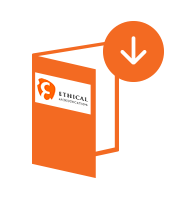The new eAdjudication® DICOM solution integrates the Orthanc PACS server and a fully-equipped viewer that facilitate the acquisition, storage, transmittal and display of images for Sponsors, CROs and Endpoint Adjudication Committee users. Image review has indeed become an important component of endpoint adjudication in clinical trials with DICOM being the standardized format for medical images. With this new integrated solution, Ethical proves once again its ability to adapt to the evolving needs of current and future customers in the fast-paced and demanding environment of life sciences.
A flexible – manual or automatic – upload of images & redaction of metadata
The new eAdjudication® DICOM solution allows customers to upload images into the system either manually or automatically in batches, depending on study requirements. Likewise, redaction of image metadata can either be performed manually, by the sponsor central staff or Ethical adjudication coordinator, or automatically at the integration according to predefined criteria.A fully integrated viewer easily accessible from the event page
The new eAdjudication® DICOM solution fully integrates a DICOM viewer that allows Endpoint Adjudication Committee members to easily access the images simply by clicking on a link opening a new tab in their browser. Once on the viewer, Committee members have access to a full range of tools to view and manage the images. However, if preferred and subject to sponsor’s approval, Committee members may download the images to view them on their own viewer installed on their individual computer.

A screenshot from eAdjudication's DICOM Viewer
The proven lightweight DICOM Orthanc Server for sharing medical images
The lightweight Orthanc PACS server chosen by Ethical for eAdjudication® is widely used within the medical community and particularly in hospital settings for storing and easily sharing medical imaging exams. Ultrasounds, X-rays, PET Scans, CT Scans, MRIs, or ECGs have become routine exams, both for diagnosis and therapeutic purposes, often replacing previous invasive procedures. With this, and because image assessment is recognized as subjective and potentially biased, adjudication data packages contain medical images more often than not. Proven technology must be in place to share medical images with Adjudication Committee members and facilitate their review.
Ethical is pleased to have launched its new comprehensive eAdjudication® DICOM solution so that current and future customers are better equipped to conduct their clinical endpoint adjudications including when these involve the review and assessment of DICOM images.
DICOM: the open standard format for medical images
According to the official DICOM website (www.dicomstandard.org), DICOM:
1) Makes medical imaging information interoperable
2) Integrates image-acquisition devices, PACS, workstations, VNAs and printers from different manufacturers
3) Is actively developed and maintained to meet the evolving technologies and needs of medical imaging
4) Is free to download and use.
However, the most important advantage of DICOM lies in the ability to separate the pixel-based image from the associated metadata, making anonymization or encryption of identifiers for data privacy compliance an easy process.
PACS: A PACS (Picture Archiving and Communication System) is a medical imaging technology which provides economical storage and convenient access to images with the ability to deliver timely and efficient access to images, interpretations and related data. The universal format for PACS image storage and transfer is DICOM
Some history
Until the early 1980’s, medical imaging review consisted mostly in printing x-ray negatives and sending them by mail to radiology experts; it was very difficult for anyone other than manufacturers of computed tomography (CT) or magnetic resonance imaging (MRI) devices to decode the digital images that their machines generated.
In 1983, the American College of Radiology (ACR) and the National Electrical Manufacturers Association (NEMA) formed a standards committee to “meet the combined needs of radiologists, physicists and equipment vendors”.
In 1985, the first standard covering point-to-point image communication, ACR-NEMA 300, was released and, in 1993, the name was changed to DICOM (Digital Imaging and Communications in Medicine).
Today, DICOM is everywhere and has become the de facto standard for digital communication and storage of medical images.
DOWNLOAD NOW THE FREE ENDPOINT ADJUDICATION HANDBOOK
The Complete Manual / Reference Book (34 pages) with all the topics related to the Independent Endpoint Adjudication Committees Management




